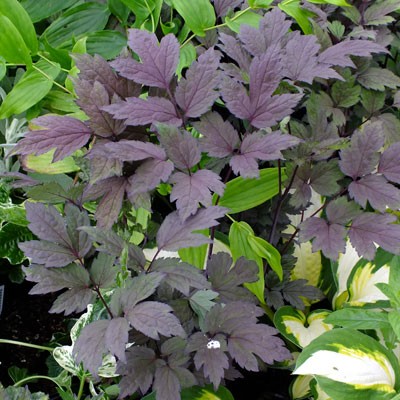-
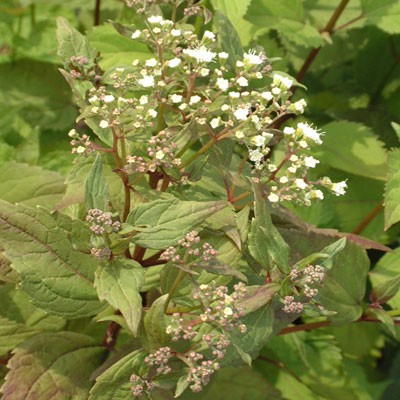

Potsize - 1L
Not a big blousy primadonna, but nevertheless a useful plant full of its own charms. Useful as it is late flowering with compact heads of small white snowballs which are just full of nectar. The leaves are fresh apple green with stems that will colour up mahogany if the plant is in sun. Tones in well with other plants and a good clean colour for a white scheme. Equally at home in the border of wild garden. 100-150cmDiscount of 25p per plant for quantities of 3 or overLinks
High and Mighty
Botanical Style Photographs
-
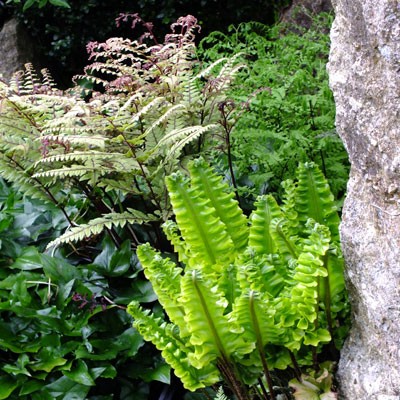
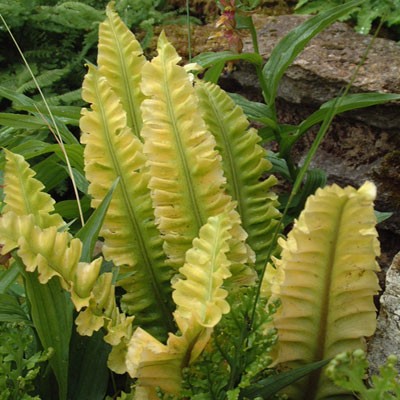
This is a great form of Hart's Tongue fern that is little seen. It was given to us years ago by Mike and Dilly Smith and it has been brightening the garden by our back door ever since, getting better by the year. It is a fine member of the Crispum Group with deeply ruffled edges to the leaves that are worthy enough on their own. However, given sufficient light, the leaves are a rich yellow for most of the Spring, only darkening to green late in the Summer. The light is essential to get the golden colour, but direct sun will cause the leaves to burn. In shade it will be entirely green, but somewhere in-between it can show partial yellowing or even variegated stripes. Asplenium Scolpendrium 'Bolton' is very similar. 30-40cm tall. It is sterile and difficult to propagate.Potsize - 1L
Links
Ferns - Garden Pictures
Ferns for Moist Sites
Ferns for Dry Sites
Ferns - Deciduous or Evergreen
Botanical Style Photographs
-
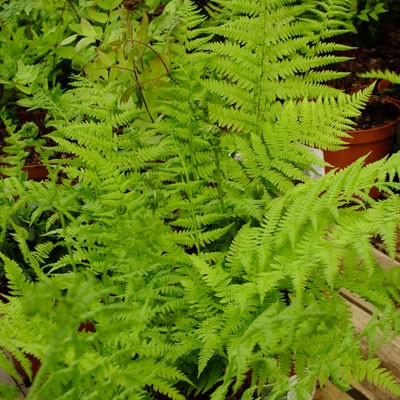
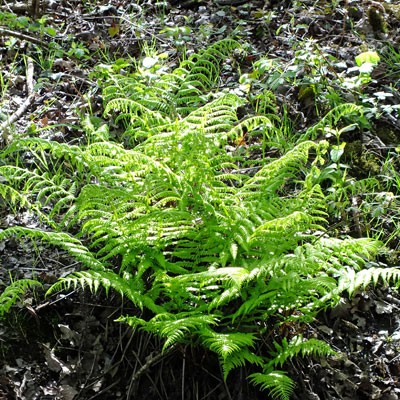
Potsize - 1L
This is the plain native form of Lady Fern, a plant that can be found throughout Britain growing in damp shady sites, but avoiding calcareous soils. It is an extremely hardy species and one that is quite variable from bipinnate to tripinnate sometimes. Whichever, it has a finer appearance than the Male fern and to my nose it is one of the 'ferniest smelling' of the ferns. It is fairly soon cut down with the onset of the frosts and is fully deciduous. Whilst a moist atmosphere is always an advantage and that coupled with a moist site will allow this fern to show of its best, once established they will actually tolerate quite dry sites, though with a cost on performance and leaf quality in dry spells.Discount of 25p per plant for quantities of 3 or overMore About Ferns
The Fern Order (Taxonomical List)
Botanical Style Photographs of Ferns
-
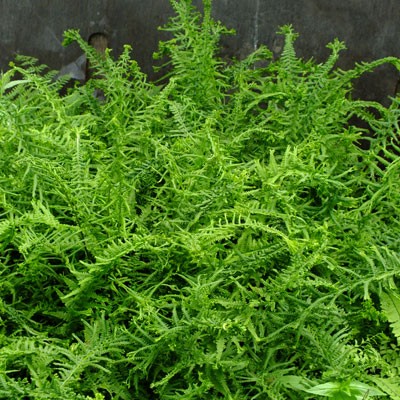
Potsize - 1L
This is the cruciate form of our native Lady fern. The leaves retain the lovely delicate nature of the species, but are distinguished in that alternate pinnae along the frond point either up or down from the plane of the leaf so that, were you to look down the length you could see a cross pattern. Often referred to as The Queen of the Ferns, it was a much treasured Victorian find. The tip of each pinna is also slightly crested which accentuates the overall frond outline. As with the native form, this is best in light shade with access to moisture at all times. grows to 90cm maybe a little more.Discount of 25p per plant for quantities of 3 or overMore About Ferns
The Fern Order (Taxonomical List)
Botanical Style Photographs of Ferns
-
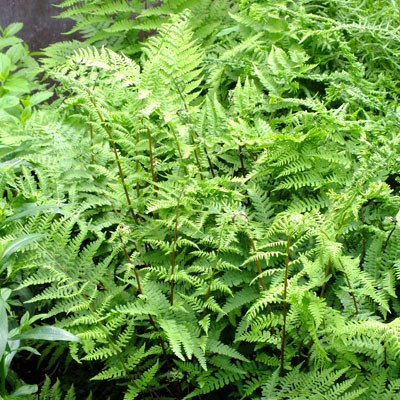
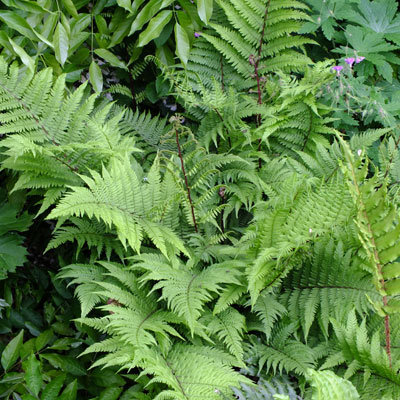

RHS AGM
Potsize - 1L
This is a selection of the North American form of our native Lady Fern which has stipes (frond stems) that are picked out in a rich ruby red. The full colouration is not apparent on young plants, but increases after plants have passed through their first frosty winter and then intensifies with age. Good nutrition will also intensify the colour. Overall the fronds are delicate in texture and posses that lovely 'ferny smell' when brushed. Needs constant access to moisture to grow at its best, achieving 90cm in height. Discovered in Vermont by John Lynch of the New England Wildflower Society.Discount of 25p per plant for quantities of 3 or overMore About Ferns
The Fern Order (Taxonomical List)
Botanical Style Photographs of Ferns
-
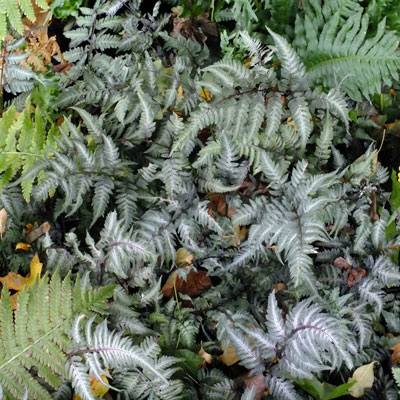
Potsize - 1L
Japanese Painted Fern. One of the many fine cultivars of this already lovely fern. Each frond begins the season green, ageing with a metallic silvery sheen which is further enhanced by rosy red etching and shading . Fronds are broad and grow fairly horizontally such that a plant will give good ground coverage when in leaf. A lovely fern worthy of a little care and a moist shady spot where it will prove most hardy. 45cm. DeciduousDiscount of 25p per plant for quantities of 3 or overMore About Ferns
The Fern Order (Taxonomical List)
Botanical Style Photographs of Ferns
-

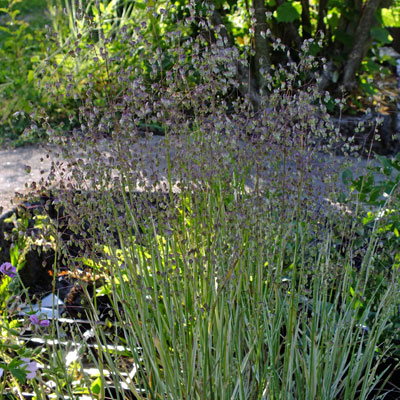
Potsize - 1L
A pretty quaking grass with tidy mounds of soft glaucous leaves with handsome white edges and striping. In Summer, dainty wands of little dancing lockets are produced which sway in the breeze. Green-white at first and often tinged with pink, the seed heads become golden with age. Semi-evergreen clumps of leaves. Not a very long lived plant but careful regular division can extend its life. Seedlings do not come true. 50-70cm in flower, 30cm in leaf.Discount of 25p per plant for quantities of 3 or over -

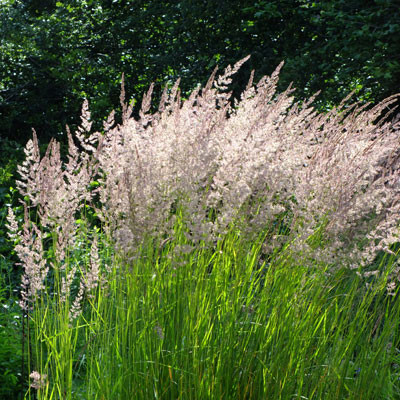
Potsize - 1L
Feather Reed Grass. This fine variety was named after the distinguished German nurseryman Karl Foerster (1874-1970) who selected and introduced it. It is a sterile hybrid (C.arundinacea x C.epigejos) and forms a narrow column, 60cm high in leaf and 150cm plus in flower. The flower spikes are narrow feathery plumes, purpley green to start, ageing a lovely golden shade in Autumn and persisting well into the Winter. It will tolerate a wide range of soils, including heavy clay and compacted soils and whilst it prefers a sunny drier site, it will tolerate a wet site well. The first grass to win Perennial Plant of the Year, which it did in 2001Discount of 25p per plant for quantities of 3 or over -

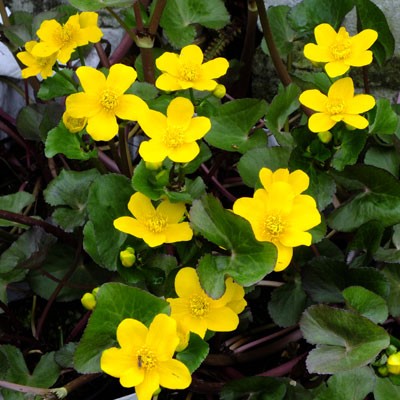

Bee Friendly
Potsize - 1L
A lovely variety with leaves that begin the year a rich bronze in colour. This colour fades as the flower stems develop so that by the time the plant is in full flower the leaves have toned down to a rich dark green with just the flower stems showing a purple flush. However the contrast of dark leaves and shining sunshine yellow flowers as they first emerge from the buds is a most beautiful thing. A variety that deserves to become well known. Marsh Marigolds are amongst the first flowers of Spring, flowering throughout the month of April.Discount of 25p per plant for quantities of 3 or over -
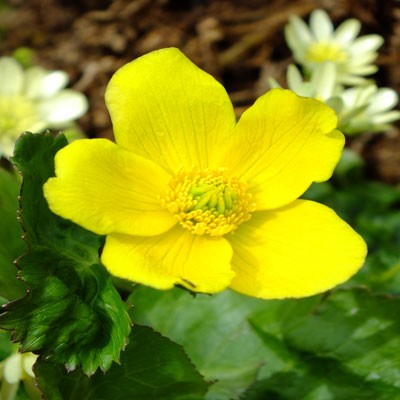
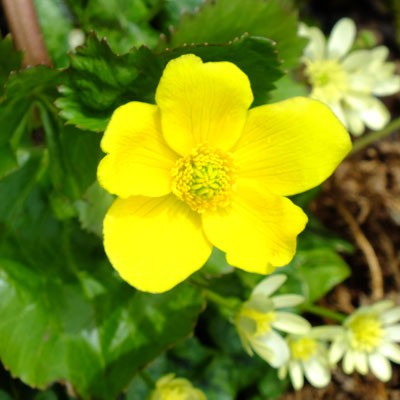

Bee Friendly
Potsize - 1L
There are two factors that set this lovely variety apart, its size and its colouring. It is larger than the species and perhaps a little more upright with leaves that are of a fresher paler green, held on pink stained petioles. The flowers, which are also large, are of a bright lemon yellow rather than the more chrome yellows of most varieties. Will root from the nodes on the flower stems. Can be planted on the pond margin or just into the water. 45cm. Marsh Marigolds are amongst the first flowers of Spring, flowering throughout the month of April. -
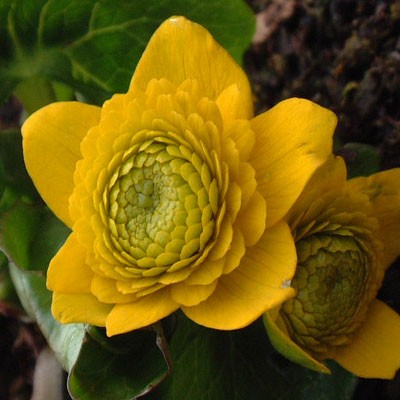
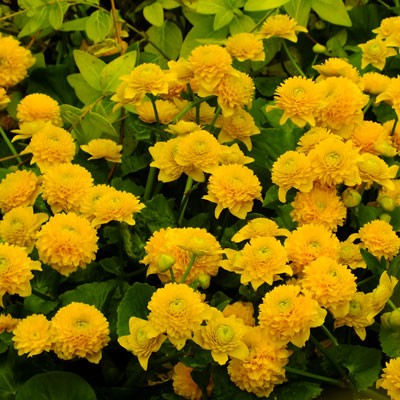

Bee Friendly
Potsize - 1L
As Marsh Marigolds go this one is relatively compact in growth, shorter in all its parts. However it is the flowers that are the chief attraction. They start off looking like a normal Marsh Marigold with the tightest anemone centre you could imagine. Then, as the flowers age, the centre petals grow out until you have a full blown miniature pom-pom dahlia of a flower in rich glowing gold. 30cm spread. Marsh Marigolds are amongst the first flowers of Spring, flowering throughout the month of April.Discount of 25p per plant for quantities of 3 or over -
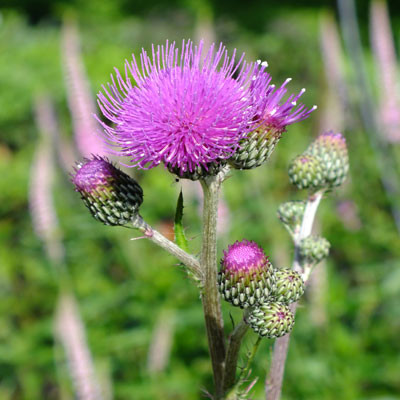

- Butterfly Friendly
- Bee Friendly
Potsize - 1L
Queen Anne Thistle. This is a native thistle from Europe, being found right across into Russia. It's no shrinking violet, but unlike some of the other members of the Cirsium genus it tends to stay put in one place and not become 'weedy'. It grows a generous basal rosette of largely non-spring leaves and throws up tall branching flower spikes up to 2m plus topped with generous thistle-knobs at the top. If you have the space its a great statement plant and great too for the wildlife, providing nectar for insects, seeds for the finches and a food plant for Painted Ladies. For a moist soil.Discount of 25p per plant for quantities of 3 or overLinks
Botanical Style Photographs
-
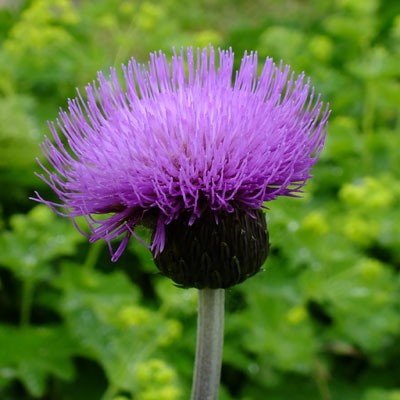
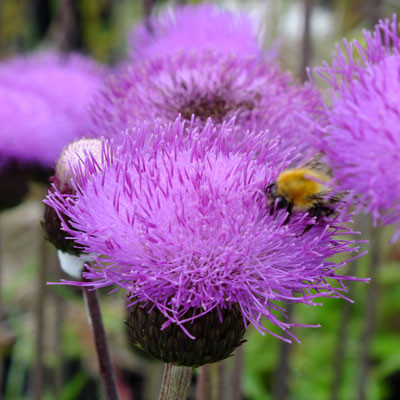
- Butterfly Friendly
- Bee Friendly
Potsize - 1L
Melancholy Thistle. Broader leaves, a more spreading habit and larger flowers than its cousin Cirsium rivulare. Later in the year to flower as well. The reason for the name heterophyllum comes from the variability of the leaf form, which becomes more divided on the flowering stalks than the basal rosettes. In shade this plant will grow well but flower poorly. Give it plenty of moisture and sun to see it at its best. The plant was considered a possible cure for sadness. Nicholas Culpepper in 1669 said that it "makes a man as merry as a cricket" Discount of 25p per plant for quantities of 3 or overLinks
Botanical Style Photographs
-

Potsize - 9cm
Convallaria majalis. Lily-of-the-Valley. One of those perennials that really needs no introduction. It is native to Britain and is particularly common on Lime rich soils, growing thick tangled mats of root in woodland situations. Each node produces two broad leaves in the middle of which nestle the stiff little spikes hung on One side with little fragrant white bells, Each with a narrowed frilly opening like an old-fashioned maids bonnet. Lily-of-the-Valley is easily grown and adaptable and particularly suited to leaving alone in difficult dry situations where It will happily carpet and provide fragrant little posies Each SpringDiscount of 25p per plant for quantities of 3 or overLinks
Lily-of-the-Valley - Botanical Style Photographs
-
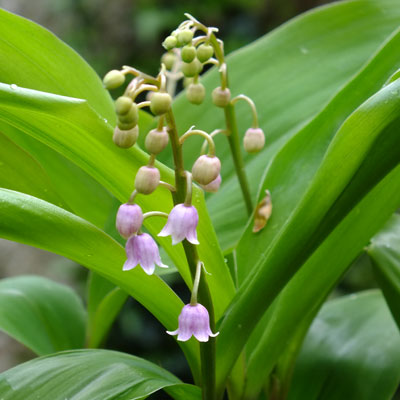

Potsize - 1L
This is the pink flowered form of Lily of the Valley. I recently read it described as 'a stunning new variety' but I'm going to resist such hyperbole. It is pleasant and different with a subtle, if a liitle dull, pink shading on the outside of each bell. The leaves are a little bluer in shade as well. Its a great addition to a collection and I don't want to denegrate its charms, just don't ecpect to have your socks blown off and you'll be well pleased.Discount of 25p per plant for quantities of 3 or overLinks
Lily-of-the-Valley - Botanical Style Photographs
-

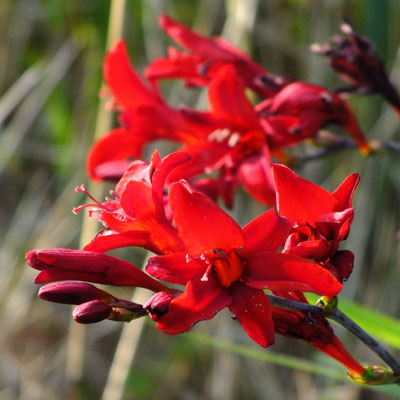
Potsize - 1L
Aptly named, this has to be one of the best new red Crocosmias. Intensely vermillion red, the wide petalled big flowers have no hint of orange, while the throat burns even darker. The narrow pleated leaves are upright rather than floppy and are not as tall as the old Lucifer, nor as inclined to spread. Flowering at 90-120cm in July and August and into September these blooms prefer a not-too-dry position and are very effective in 'hot' schemes.Discount of 25p per plant for quantities of 3 or overLinks
Crocosmias compared
-
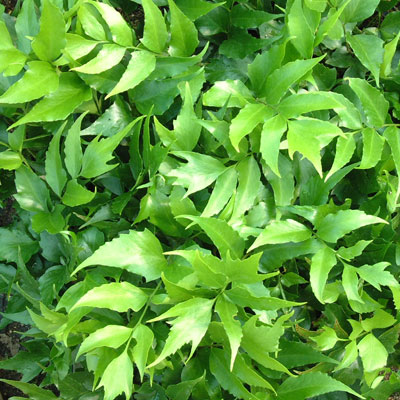
Potsize - 1L
The deep glossy forest green fronds of this fern with its broadly pinnate pseudo-holly foliage makes a wonderful focal point amongst its lacy cousins or a fine evergreen for shade in its own right. It grows to 75cm (30") and can look handsome all year, especially if protected from bitter winds. Good even in deep shade given woodsy friable soil. It will burn if grown in full sun. native of Asia (Korea, China, Vietnam and Thailand and especially Japan where it makes its home in a wide range of environments from urban walls to forest floors.Discount of 25p per plant for quantities of 3 or overLinks
Ferns - Garden Pictures
Ferns for Moist Sites
Ferns for Dry Sites
Ferns - Deciduous or Evergreen
-
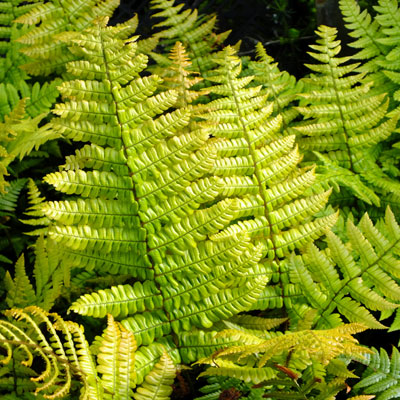

Potsize - 1L
This lovely new variety was discovered by Bob Hollister in Dorset close to the Jurassic Coast and introduced in 2018 (Best New plant Chelsea 2019). Dryopteris wallichiana is already a fine specimen fern, but in this variety the distinctive black-scaled croziers unfurl to new fronds with amazing golden shading. Fronds mature to a gold and light green mix. Semi-Evergreen in a sheltered spot. 60-75cm, 50cm spread.Links
Ferns - Garden Pictures
Ferns for Moist Sites
Ferns for Dry Sites
Ferns - Deciduous or Evergreen
Botanical Style Photographs
-
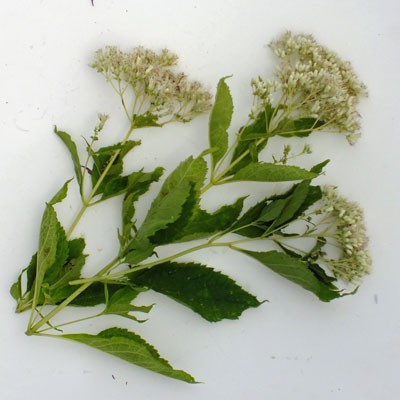
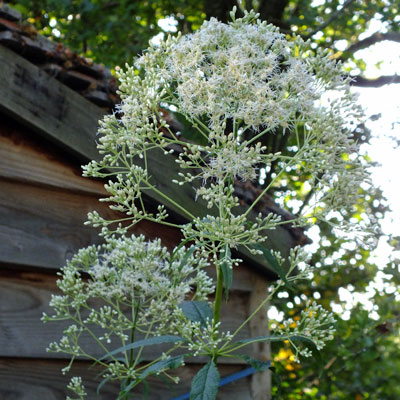
- Bee Friendly
- Butterfly Friendly
Potsize - 1L
A really big, bold statement of a plant for the back of large borders. Great clouds of ivory coloured, almost white, soft fluffy flowers sway on grey green stems which are richly clad in handsome whorls of fresh green foliage. A handsome architectural plants which can top 2m and is irresistible to insects. Flowering from July-September. Please don't expect to receive it in flower in Summer !Links
High and Mighty
Botanical Style Photographs
-
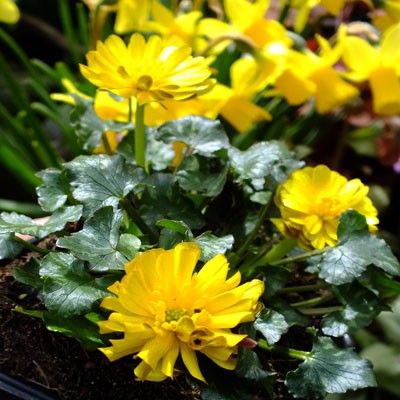
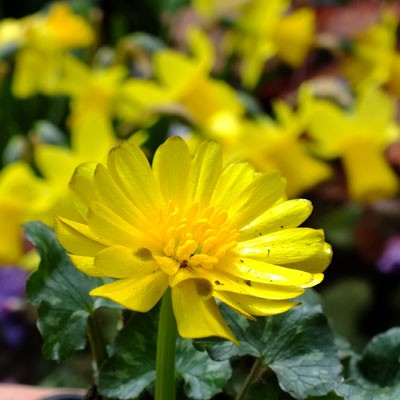
Potsize - 9cm
Lesser Celandine. Gold-edged, bronze buds open to a typical celandine colour, the difference being that Ficaria verna 'Montacute' (Ranunculus ficaria) has 4 ruffs of petals, prettily incurved to reveal the contrasting bronzy reverse. The petals are neatly square-ended, almost as if they have been trimmed. Unlike 'Flore Pleno' the centres of the flowers are open revealing a green eye surrounded by a boss of orange anthers. The leaves are arrow shaped, green flecked with silver. A favourite of mine and one of the earliest to flower. Said to have been rescued from a verge in Montacute, Somerset in 1994 just prior to being destroyed in roadworks. -
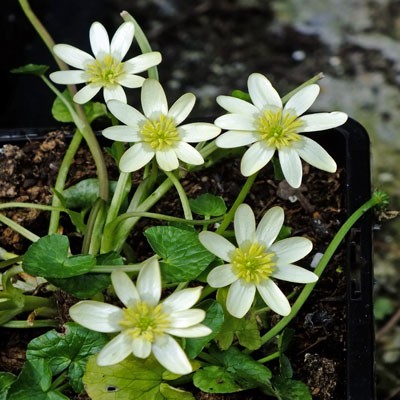
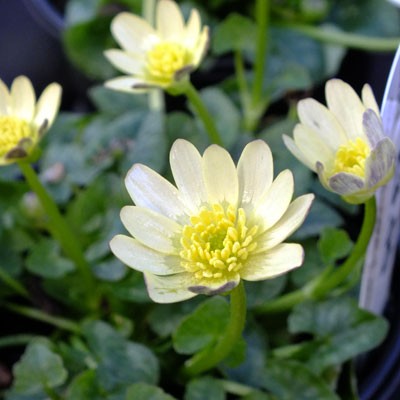
Potsize - 9cm
Lesser Celandine. Glossy Buttermilk petals, shaded purplish on the reverse set off by a central boss of double-cream stamens. A nice contrast to the other cultivars or where the bold yellows are a bit too strident. Plain green leaves. This selection comes from Allan Robinson, former Rock Garden Superintendent at Wisley, who named it after his cat. -
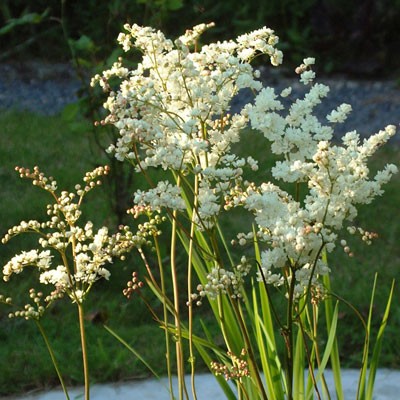
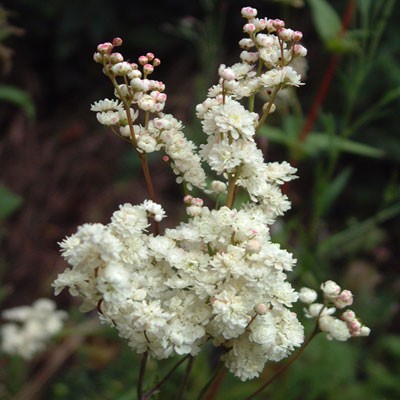
Potsize - 1L
(Filipendula hexapetala 'Flore Pleno') I love this double form of meadowsweet. It has a gentle elegance with its coral-bronze buds opening to clusters of creamy white, tiny double 'roses' all carried on bronzy wiry stems. Attractive rosettes of dark ferny foliage (a bit like Achillea foliage all beefed up). I can just imagine this in a country brides bouquet, long before gypsophila was ever invented. 45cm high in flower in mid-summer. Unlike most Meadowseet this comes from upland chalk, and whilst not being a water lover, neither does it appreciate drought . As to alkalinity it seems remarkably indifferent. -


Potsize - 1L
A fitting name for this lovely Geum. It has 5 rows of frilly petticoat-like petals in a warm soft yellow, all suffused with peach. The centre of each flower has a big boss of yellow stamens tipped with brown anthers all ringed around with the red styles in the middle. Flip the flower over and you find it is washed over in a lovely apricot shade with a dark red calyx and stem. All in all its enough to get you grabbing your skirt and bursting into song. Discount of 25p per plant for quantities of 3 or overLinks
Geum Varieties Compared
Botanical Style Photographs
-
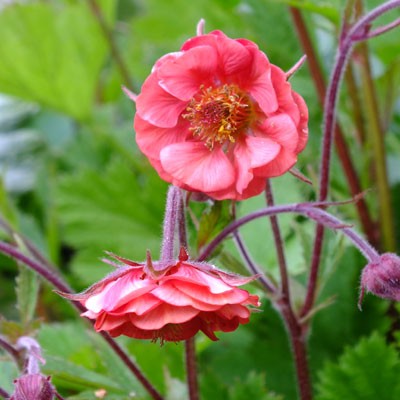

Potsize - 1L
I think this is a slow burner rather than a red hot Latin lover, but it's certainly a Geum to fall in love with. Geum 'Flames of Passion' is relatively short and neat at a foot high. The flowers are 2cm across and look down in a rather coy fashion. They are strawberry pink, slightly ruffled with 3 rows of petals and a charming yellow centre with a green eye. The dark maroon buds and stems round off the effect nicely. So if you are feeling coy yourself, perhaps it's time to give passion a try. Discount of 25p per plant for quantities of 3 or overLinks
Geum Varieties Compared
Botanical Style Photographs
-
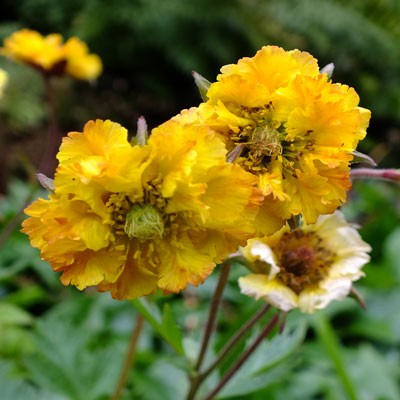

Potsize - 1L
Like Can-can this neat little Geum has warm yellow petals tipped and suffused with coppery peach tones. It has 3 rows of petals which are not only ruffled but also beautifully frilly at the edge. The effect is neat, delicate and quite charming. The centres of new flowers are fresh pale green with a big boss of yellow tipped anthers whilst the stigmas are so many they are twisted together. The nodding buds are wrapped in pomegranate red calyces with similirly coloured stems. Discount of 25p per plant for quantities of 3 or overLinks
Geum Varieties Compared
Botanical Style Photographs
-

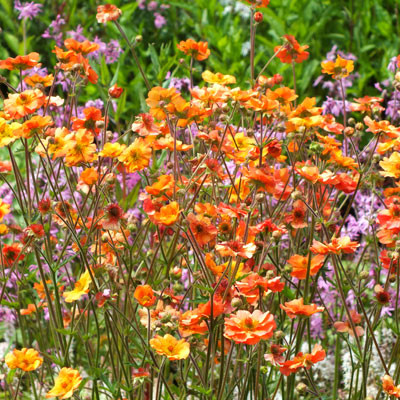
Potsize - 1L
Introduced by Hardy's in 2010, this Geum has built up a great reputation for reliability and impact. It is a sterile hybrid that will hold its zingy semi double orange flowers on stems up to 90cm tall and keep on producing them over an extended season. The flowers can vary in shade from a rich orange back towards a more mellow shade. From a distance it reminds us somewhat of Geum 'Hilltop Beacon' but the growth habit is much more upright and tighter packed. Discount of 25p per plant for quantities of 3 or overLinks
Geum Varieties Compared
Botanical Style Photographs
-

Potsize - 1L
Oak Fern. A verdant treasure of the freshest green. The short but upright stems carry their pinnae horizontally, an attractive feature. They are said to resemble an Oak's leaves, hence the species name dryo (Greek drys - Oak), pteris (fern), but this takes a bit of a leap of imagination that I have failed to muster ! It is however a really lovely little deciduous fern for ground cover in moist shady places on non-alkaline soils. The books say it needs acid soil, but our improved Oxford Clay at neutral pH seems to suit it well. It is a British Native and is found very widely if sporadically in woods over much of Continental Europe and N.America. Only 20cm high and a slow but natural spreader. Deciduous.Discount of 25p per plant for quantities of 3 or overLinks
Ferns - Garden Pictures
Ferns for Moist Sites
Ferns for Dry Sites
Ferns - Deciduous or Evergreen
Botanical Style Photographs
-
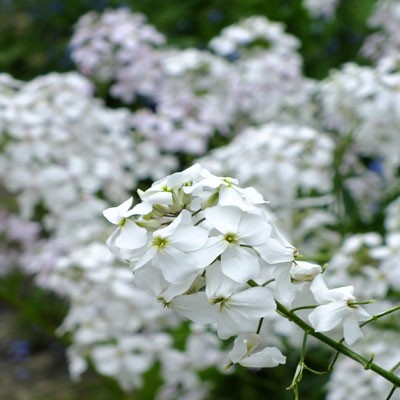
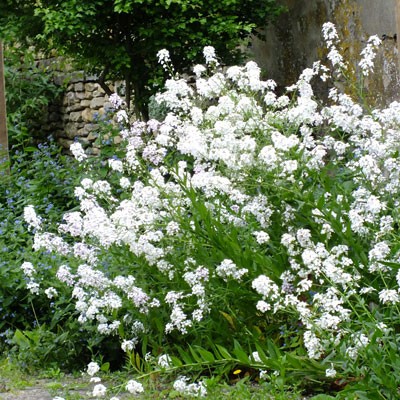
Potsize - 9cm
Dame's Violet, Sweet Rocket. Tall slender stems, 100 to 120cm, with 4 petalled flowers. Heads of highly perfumed flowers reminiscent of willowy stocks. Much loved by pollinating insects. An old Cottage Garden favourite. Short lived, but good for naturalising in damp, shady or grassy places. Discount of 25p per plant for quantities of 3 or over -
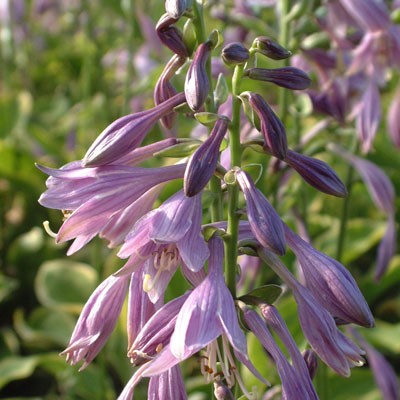
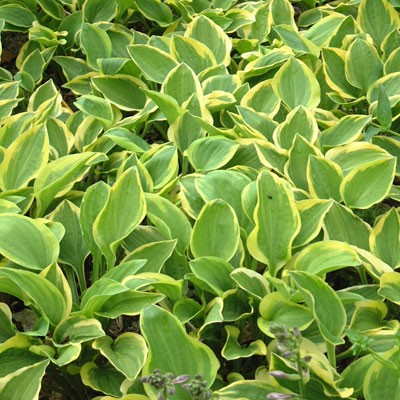

RHS AGM
Potsize - 1L
Small-Medium. H.capitata origin. R.Savory 1977. A really quick grower that bulks up in no time. Relatively small leaves, which broaden to oval as the plant matures, in mid green with a yellow margin that fades to cream. For its small size, the flowers are quite tall, abundantly produced in strong lavender, stronger in sunlight.Discount of 25p per plant for quantities of 3 or overLinks
Hostas Compared
Hostas in the Garden
Botanical Style Photographs
-

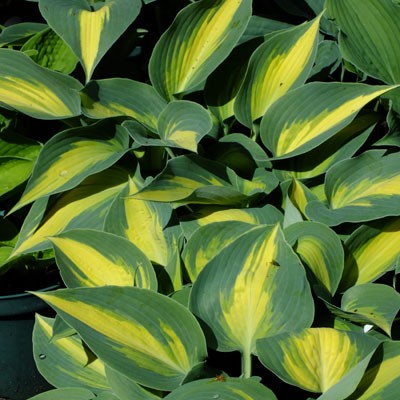
Potsize - 1L
Medium. Identical to H.'Touch of Class'. Sport of H.'Carder Blue' possibly. M.Lavana/A.Malloy. Still a very good Hosta and one of the earliest to come to flower. Broad blue leaves with a strong yellow centre. Recorded as being similar to June except for a more solid broad blue edge.Discount of 25p per plant for quantities of 3 or overLinks
Hostas Compared
Hostas in the Garden
Botanical Style Photographs
-
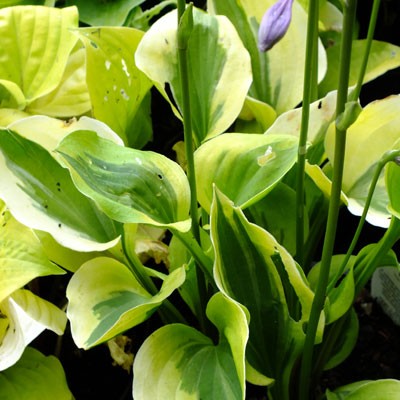
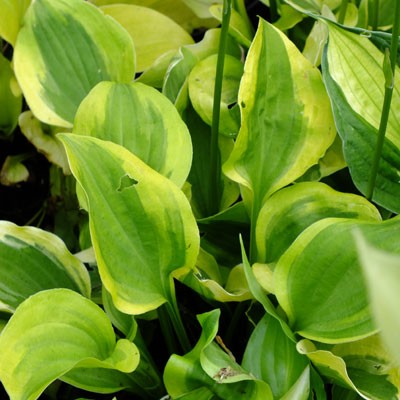
Potsize - 1L
Small-Medium. Tissue culture sport of H.'Golden Tiara'. A,Pollock 1991. Like its parent, this is a quick growing variety. The main distinction is that the yellow edge is much broader, at least half the width of the leaf. Leaf colour better with some morning sum. A polyploid sport, ie it has extra chromosomes, which give the leaves a thicker texture.Discount of 25p per plant for quantities of 3 or overLinks
Hostas Compared
Hostas in the Garden
Botanical Style Photographs
-
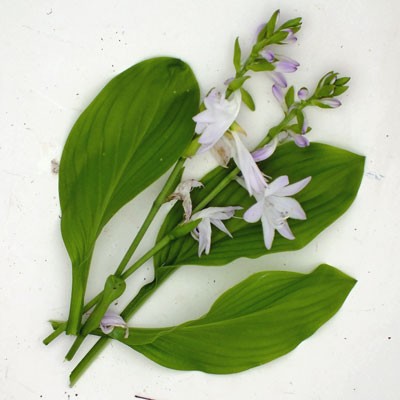
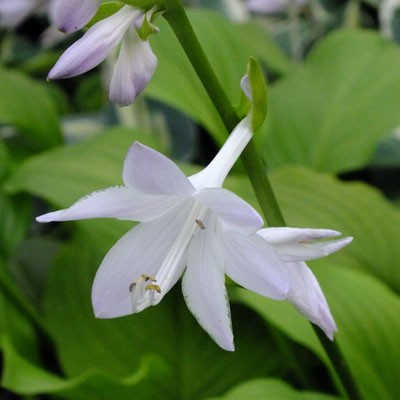

RHS AGM
Potsize - 1L
Medium-Large. H.plantaginea x H.sieboldii. A.Cummings & AHS 1986. We've found this variety to be very tough in the garden, and relatively resistant to slugs despite its soft appearance. The leaves are a simple elegant apple green, long and tapered in shape. As you would expect from a plantaginea cross, the flowers are large and fragrant (with perhaps just a whiff of aniseed?), lilac in bud, opening white. It is very tolerant of sun which is said to bring out the fragrance but deteriorates the foliage colour.Discount of 25p per plant for quantities of 3 or overLinks
Hostas Compared
Hostas in the Garden
Botanical Style Photographs
-
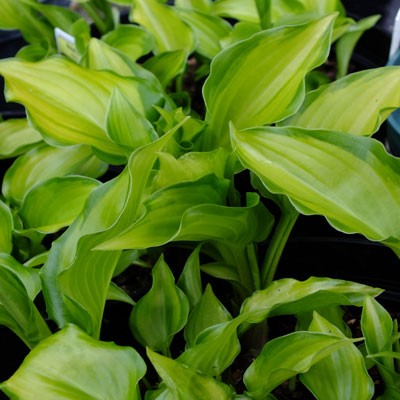
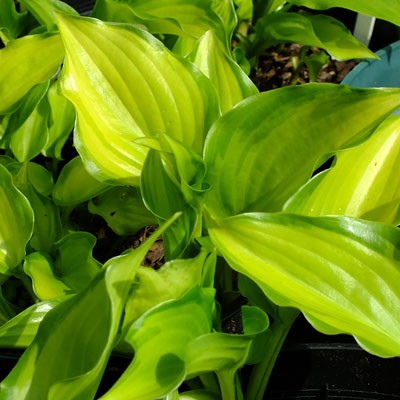
Potsize - 1L
Medium. Begins with shiny yellow leaves with very red petioles. A seedling from H.'Invincible'. B.Zonneveld/H.Philips. By mid Summer this is hard to tell from Invincible, but in Spring the leaves emerge yellow with a narrow green edge, greatly enhanced by the shine on the leaves. The yellow colour, whilst striking at the time, fades quite quickly.Discount of 25p per plant for quantities of 3 or overLinks
Hostas Compared
Hostas in the Garden
Botanical Style Photographs
-
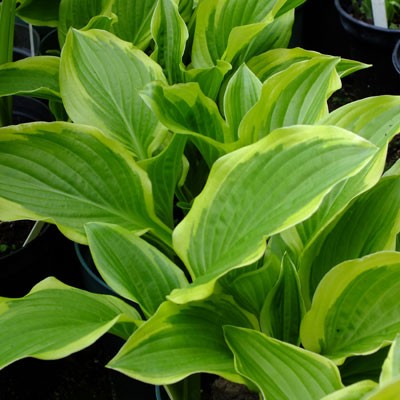

Potsize - 1L
Medium. H.plantaginea x H.'Tokudama Aureonebulosa'. V.Sellers. From its plantaginea parent this variety inherits marvellous flowers. Large, fragrant and outward facing they open on tall straight scapes from lilac buds, becoming white with lilac veins. The foliage is no slouch with a broad yellow margin, fading cream around a solid green centre.Discount of 25p per plant for quantities of 3 or overLinks
Hostas Compared
Hostas in the Garden
Botanical Style Photographs
-


Potsize - 1L
Medium. (Tardiana Group) A seedling from H.'June' or possibly H.'Devon Green'. J. van den Top. This is very much along the same lines as June is when young, the difference being that June Fever looks like the contrast knob has been dialled to maximum. The Spring leaves are a bright glowing yellow with a narrow green edge. the colouring gradually fades to chartreuse, retaining more of a narrow edge than that of June which gets broader on older plants. Discount of 25p per plant for quantities of 3 or overLinks
Hostas Compared
Hostas in the Garden
Botanical Style Photographs
-

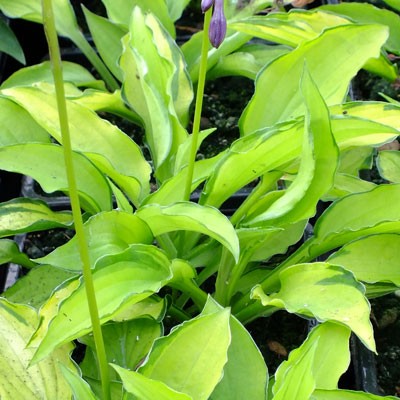
Potsize - 1L
Very Small. A similar variety to 'Lemon Lime' except that this variety has a narrow dark green edge to each narrow chartreuse coloured leaf. A very vigorous and fast growing Hosta which can be used as ground cover in the garden or can alternatively be reduced to bonsai culture. Forms dense mounds of foliage and abundant flowers on relatively tall spikes. Flowers outward facing mauve trumpets.Discount of 25p per plant for quantities of 3 or overLinks
Hostas Compared
Hostas in the Garden
Botanical Style Photographs
-
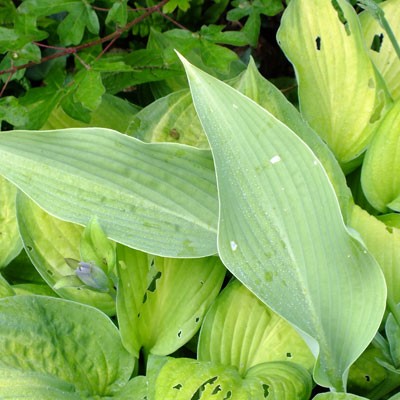

Potsize - 1L
Large. Possibly a H.nigrescens hybrid. Ullrich Fischer. Quite similar in many ways to H.'Krossa Regal', differing in that the leaves are maybe a little narrower on longer petioles and slightly darker in colour. In spring they are very thin and snake-like in the way that they unfurl from narrow pointy buds. A fine cultivar if a little slow.Discount of 25p per plant for quantities of 3 or overLinks
Hostas Compared
Hostas in the Garden
Botanical Style Photographs
-

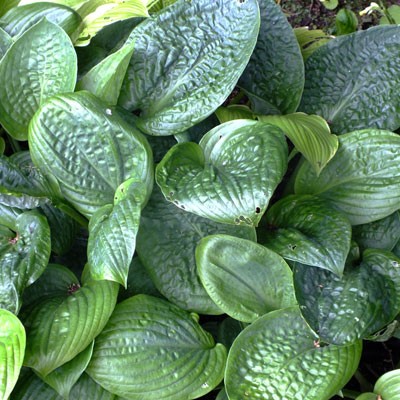
Potsize - 1L
Large. H.yingeri x H.'Blue Umbrellas'. T.Avent 1995. A big bold Hosta with well rounded, well puckered leaves. Quickly makes a large, if not shapely mound of tough leathery textured leaves that are noted for their deep blue green colouring. Vigorous grower. Surprisingly small and delicate pink flowers for such a butch Hosta.Discount of 25p per plant for quantities of 3 or overLinks
Hostas Compared
Hostas in the Garden
Botanical Style Photographs
-
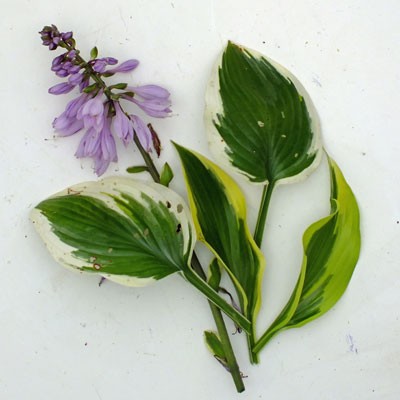
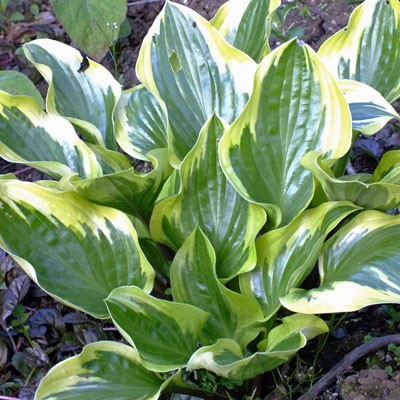
Potsize - 1L
Medium. Sport of H.'Josephine'. Kuk 1991. This is the variety to have if you are looking for glossy leaves as they can look as if they have been waxed. The centre of each long petioled leaf is a rich deep green with a bold regular margin of creamy yellow. Forms an open mound. A nice tidy distinctive variety.Discount of 25p per plant for quantities of 3 or overLinks
Hostas Compared
Hostas in the Garden
Botanical Style Photographs
-

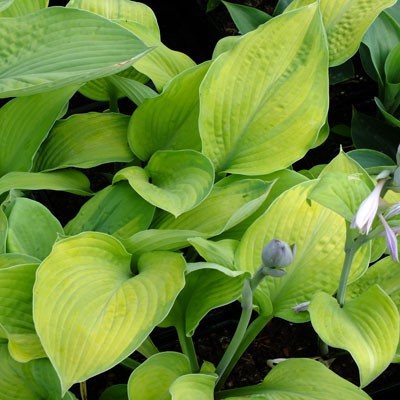
Potsize - 1L
Large. Upright grower. A sport of H.'Gold Regal'. B.Solberg. Leaves have a very nice shape with a gently undulating margin. The colouring is a pale yellow, fading more creamy in sun with a margin that is a very muted green, sometimes fading entirely. Seer suckering towards the petiole and veins retain some blue-green colouring. Forms a tight crown of leaves.Discount of 25p per plant for quantities of 3 or overLinks
Hostas Compared
Hostas in the Garden
Botanical Style Photographs
-

Potsize - 1L
Large. Heart shaped puckered leaves with a wavy margin. A seedling of H.'Wagon Wheels'. M.Seaver. A very attractive variety with its variation in leaf colour as they mature at different rates. Each one starts off chartreuse, turning a bright yellow as they age, all the time with a cream to white margin. They are quite heavily seersuckered with each pucker being accentuated by the green shading it retains.Discount of 25p per plant for quantities of 3 or overLinks
Hostas Compared
Hostas in the Garden
Botanical Style Photographs
-

Potsize - 1L
Medium-Large. (fortunei) Sport of H.'Fortunei'. T.Donahue & AHS 1986. Leaves start the season with a broad central section that is striped with cream. The colouration fades by mid Summer to a mixture of two tones of green.Discount of 25p per plant for quantities of 3 or overLinks
Hostas Compared
Hostas in the Garden
Botanical Style Photographs
-
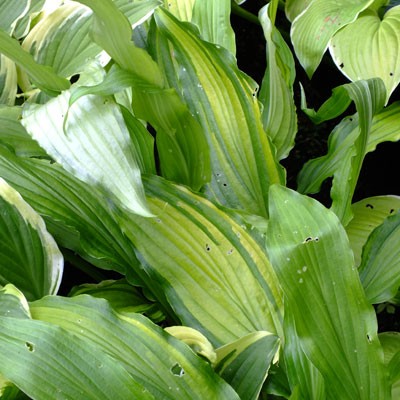
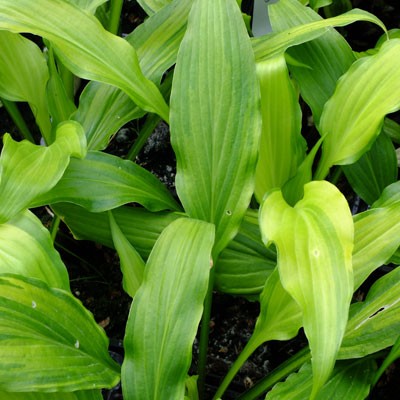
Potsize - 1L
Medium-Large. H.'Green Fountain' hybrid. P.Aden 1986. A lovely form creating a gently arching fountain of foliage which is best appreciated when grown in a pot. The leaves are long and narrow with an undulating edge. They begin the season quite yellow, fading into the season to a green yellow centre and darker edges, all overlaid with an excellent shine. Early in the season reminiscent of June Fever in colouring. Flowers pinkish on a very leafy scapeDiscount of 25p per plant for quantities of 3 or overLinks
Hostas Compared
Hostas in the Garden
Botanical Style Photographs
-
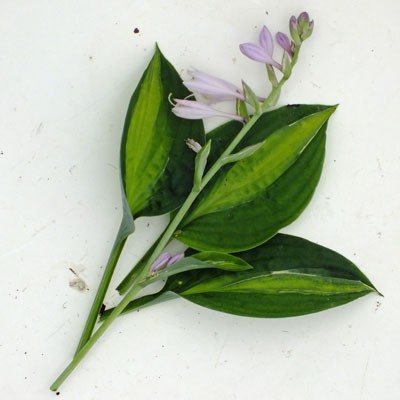


RHS AGM
Potsize - 1L
Medium. (fortunei) H.'Gold Standard' sport. C. & R.Thompson 1991. A quick growing variety with striking colouration which has sported many popular varieties. The narrow leaves have a very distinctive patterning consisting of a broad blue-green margin and apple-green, fading chartreuse centre with flecks of bright white at the junction between them. Like many Hosta, getting the light levels right is important to achieving the best colour.Discount of 25p per plant for quantities of 3 or overLinks
Hostas Compared
Hostas in the Garden
Botanical Style Photographs
-
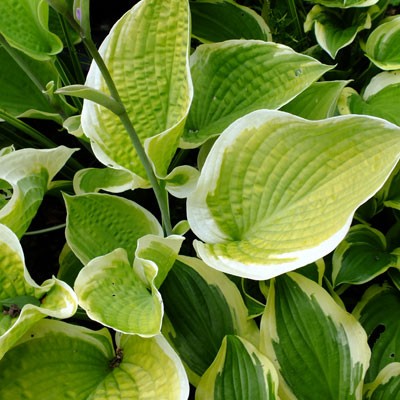
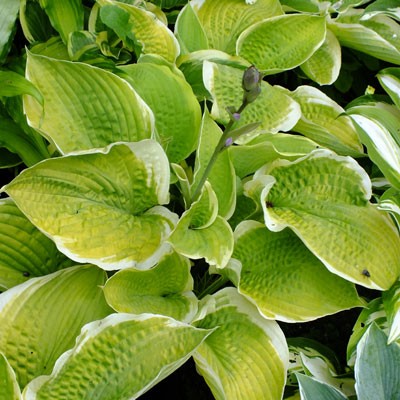
Potsize - 1L
Large. Thick corrugated texture. H.'William Lachman' x H.'Golden Waffles'.K.Vaughn. Forms a dense fountain of leaves which begin life yellow-shaded chartreuse and gradually age a much brighter lemony yellow-green with a white edge. One of the earlier varieties out of the ground. Lavender flowersDiscount of 25p per plant for quantities of 3 or overLinks
Hostas Compared
Hostas in the Garden
Botanical Style Photographs
-

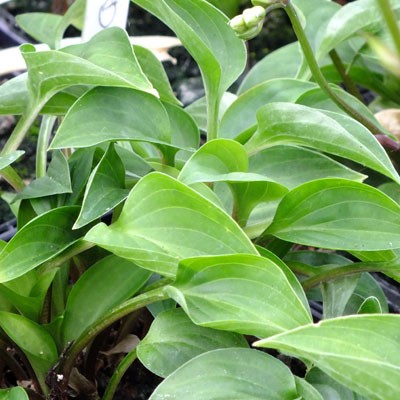
Potsize - 1L
Small. Kanzashi Giboshi. From Southern and central Korea and Japan. A form that can attain a height of 30cm, but is also very suitable for bonsai use. The leaves are a classic heart shape in a mid green. Flowering is very free with each flower a rich mauve in a nice flared trumpet on relatively tall scapes. The scapes are noticeably ridged.Discount of 25p per plant for quantities of 3 or overLinks
Hostas Compared
Hostas in the Garden
Botanical Style Photographs
-

Potsize - 1L
Lamium orvala 'Alba'. This is the pure white flowered form of this stately deadnettle. Rather than the usual ruddy pinks of the species, the dragon-mouth flowers are clean white, shading a little green from the leaves. The leaves and stems also lack the pink pigments giving the whole plant a greener, cleaner look than the species. Non invasive clumper for a nice leafy spot in moist shade. 30-45cm. Thought to have occurred in the Betws y Coed garden of E.C.Buxton.Discount of 25p per plant for quantities of 3 or over

















































